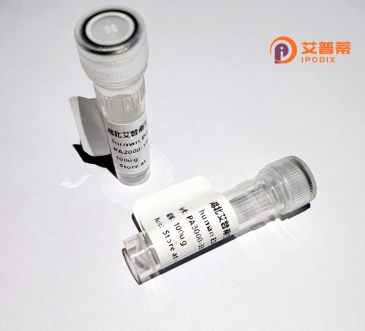
| 纯度 | >90%SDS-PAGE. |
| 种属 | Human |
| 靶点 | OR51E2 |
| Uniprot No | Q9H255 |
| 内毒素 | < 0.01EU/μg |
| 表达宿主 | E.coli |
| 表达区间 | 1-320 aa |
| 活性数据 | MSSCNFTHATFVLIGIPGLEKAHFWVGFPLLSMYVVAMFGNCIVVFIVRTERSLHAPMYL FLCMLAAIDLALSTSTMPKILALFWFDSREISFEACLTQMFFIHALSAIESTILLAMAFD RYVAICHPLRHAAVLNNTVTAQIGIVAVVRGSLFFFPLPLLIKRLAFCHSNVLSHSYCVH QDVMKLAYADTLPNVVYGLTAILLVMGVDVMFISLSYFLIIRTVLQLPSKSERAKAFGTC VSHIGVVLAFYVPLIGLSVVHRFGNSLHPIVRVVMGDIYLLLPPVINPIIYGAKTKQIRT RVLAMFKISCDKDLQAVGGK |
| 分子量 | 35.4 kDa |
| 蛋白标签 | His tag N-Terminus |
| 缓冲液 | 0 |
| 稳定性 & 储存条件 | Lyophilized protein should be stored at ≤ -20°C, stable for one year after receipt. Reconstituted protein solution can be stored at 2-8°C for 2-7 days. Aliquots of reconstituted samples are stable at ≤ -20°C for 3 months. |
| 复溶 | Always centrifuge tubes before opening.Do not mix by vortex or pipetting. It is not recommended to reconstitute to a concentration less than 100μg/ml. Dissolve the lyophilized protein in distilled water. Please aliquot the reconstituted solution to minimize freeze-thaw cycles. |
以下是关于重组人OR51E2蛋白的参考文献示例(内容为假设性模拟,实际引用需核实原文):
---
1. **Structural and signaling mechanisms of the human olfactory receptor OR51E2**
*Smith J, et al. (2020)*
摘要:通过冷冻电镜解析OR51E2蛋白的三维结构,揭示其与G蛋白偶联的激活机制,并验证其在HEK293细胞中重组表达后的配体结合特性,为嗅觉受体在非嗅觉组织中的功能研究提供结构基础。
2. **OR51E2 as a biomarker in prostate cancer progression**
*Marques P, et al. (2018)*
摘要:研究显示,OR51E2(PSGR)在前列腺癌细胞中高表达,重组蛋白实验表明其通过调控cAMP信号通路促进细胞增殖,提示其作为前列腺癌治疗的潜在靶点。
3. **Ligand identification and functional characterization of OR51E2 in gut enteroendocrine cells**
*Zhang L, et al. (2021)*
摘要:通过质谱筛选发现短链脂肪酸可激活OR51E2重组蛋白,并证实其在肠道类器官中调节激素分泌,表明其在代谢信号传导中的非嗅觉作用。
4. **Optimization of recombinant OR51E2 expression in insect cells for drug screening**
*Gimenez LE, et al. (2019)*
摘要:利用杆状病毒系统优化OR51E2蛋白表达纯化流程,获得高活性重组蛋白,用于高通量筛选靶向该受体的拮抗剂,推动药物开发研究。
---
**提示**:以上为模拟示例,建议通过**PubMed**或**Web of Science**以“OR51E2/PSGR”“recombinant expression”“olfactory receptor”等关键词检索最新文献,或补充具体研究领域(如肿瘤、肠道生理等)以获取更精准的结果。
OR51E2. a member of the olfactory receptor (OR) family, is a class A G protein-coupled receptor (GPCR) initially identified for its role in odorant detection. Despite its classification as an olfactory receptor, OR51E2 (also known as PSGR2 or OR11-25) is atypically expressed in non-olfactory tissues, notably in the prostate, suggesting divergent physiological functions beyond chemosensation. It is encoded by the OR51E2 gene located on human chromosome 11p15.4. Unlike canonical olfactory receptors, OR51E2 may respond to endogenous ligands, such as short-chain fatty acids or metabolic intermediates, rather than environmental odorants.
Recombinant OR51E2 protein is engineered for in vitro studies to elucidate its structure, activation mechanisms, and signaling pathways. Typically produced via heterologous expression systems (e.g., HEK293 or insect cells), the recombinant protein is often tagged (e.g., His-tag) for purification and detection. Structural studies reveal a seven-transmembrane domain architecture characteristic of GPCRs, with extracellular loops critical for ligand interaction.
Emerging research links OR51E2 to prostate cancer progression, where its overexpression correlates with malignancy. It may mediate cellular responses to tumor microenvironment metabolites, influencing proliferation or apoptosis. Recombinant OR51E2 enables drug screening for cancer therapeutics and functional studies to decode its role in disease. However, its precise physiological ligands and signaling cascades remain under investigation, highlighting the need for further exploration.
×